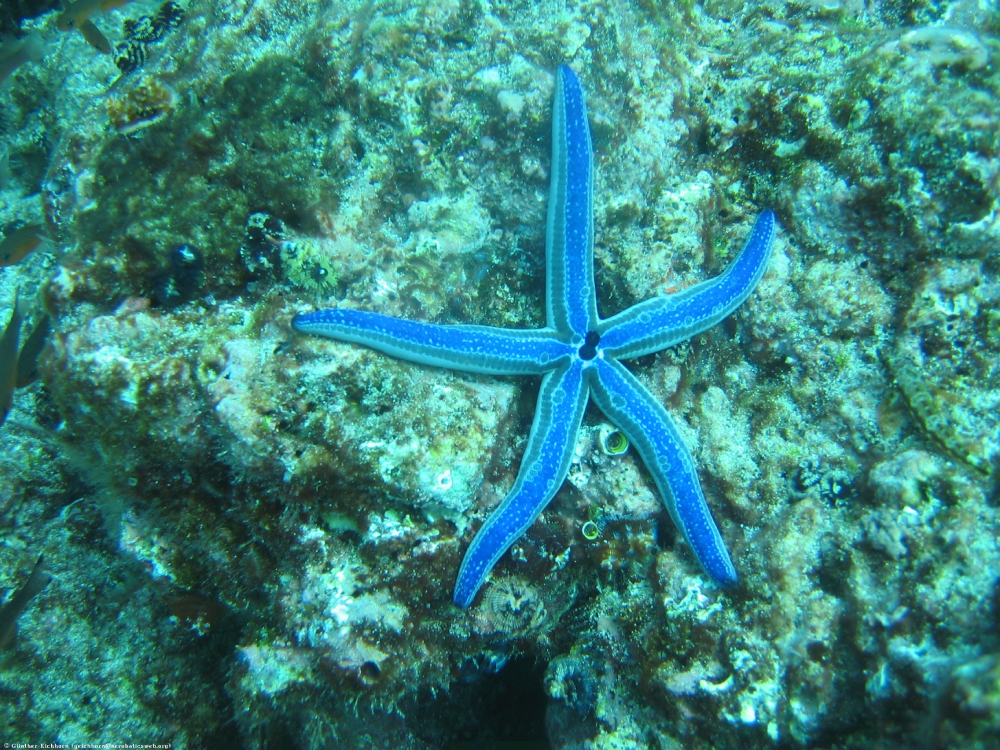Biology and Physical Characteristics
The Blue Sea Star is renowned for its vivid blue hue, although it can sometimes be found in shades of green, purple, or even orange. This color is due to the presence of a pigment called linckiacyanin, which is believed to provide some protection against predators. The starfish typically has five arms, though some individuals can have four or six due to genetic variations or regeneration after injury. Each arm can grow up to 20 centimeters long, making the total diameter of the Blue Sea Star reach up to 40 centimeters.
Like other echinoderms, the Blue Sea Star possesses a unique water vascular system, which facilitates movement, feeding, and respiration. This system is made up of a series of canals and tube feet that operate through hydraulic pressure. The central disk houses the mouth on its underside, and the starfish feeds by everting its stomach through its mouth to envelop and digest its prey externally.
Habitat and Distribution
The Blue Sea Star predominantly lives in the warm, shallow waters of the Indo-Pacific region. Its range extends from the eastern coast of Africa, across the Indian Ocean, to the western and central Pacific Ocean, including areas such as the Great Barrier Reef, Indonesia, and the Philippines.
This species thrives in coral reefs, rocky reefs, and seagrass beds, typically at depths ranging from the intertidal zone to about 60 meters. The Blue Sea Star prefers areas with abundant coral cover and algal growth, which provide ample food sources and shelter from predators.
Behavior and Diet
The Blue Sea Star is an omnivore, feeding on a variety of organic materials. Its diet primarily consists of biofilm, detritus, algae, and small invertebrates such as sponges and mollusks. It plays a crucial role in controlling algal growth on coral reefs, thereby maintaining the balance of the ecosystem.
Reproductive Behavior
The reproductive process of the Blue Sea Star is fascinating and complex. It can reproduce both sexually and asexually. During sexual reproduction, individuals release eggs and sperm into the water column simultaneously, a process known as broadcast spawning. Fertilized eggs develop into free-swimming larvae, which eventually settle and metamorphose into juvenile sea stars. Asexual reproduction occurs through a process called autotomy, where an arm detaches and regenerates into a new individual, a remarkable feat of regeneration.
Ecological Significance
The Sea Star plays a vital role in coral reef ecosystems. By feeding on algae, it helps prevent algal overgrowth, which can smother corals and hinder their growth. This contributes to the overall health and resilience of coral reefs, which are biodiversity hotspots and provide numerous ecosystem services, including coastal protection and fisheries support.
Indicator Species
Due to its sensitivity to environmental changes, the Blue Sea Star is an indicator species. Changes in its population size and health can reflect the overall condition of the marine environment, making it a valuable species for monitoring the impacts of climate change, pollution, and habitat degradation.
Despite its vivid coloration, the Blue Sea Star faces predation from various marine creatures, including fish, sea birds, and other starfish species like the Crown-of-Thorns starfish. Additionally, it is susceptible to environmental stressors such as rising sea temperatures, ocean acidification, and habitat destruction due to human activities like coastal development and pollution.

Conservation Efforts
Efforts to conserve the Sea Star focus on protecting its natural habitat and mitigating the impacts of climate change. Marine protected areas (MPAs) have been established in various regions to safeguard coral reefs and seagrass beds, providing a safe haven for this species and other marine life. Furthermore, initiatives to reduce carbon emissions and promote sustainable fishing practices are crucial for the long-term survival of the Sea Star.
Blue Sea Star in Aquariums
The Blue Sea Star is a popular addition to marine aquariums due to its striking appearance and relatively hardy nature. However, keeping this species in captivity requires specific conditions to mimic its natural habitat, including stable water parameters, adequate space, and a diet that replicates its natural feeding habits. It is essential for aquarium hobbyists to source Sea Stars from sustainable and ethical suppliers to avoid contributing to overharvesting and environmental degradation.
Conclusion
The Sea Star is not only a visual marvel of the marine world but also an integral component of coral reef ecosystems. Its role in maintaining ecological balance, coupled with its fascinating biological and behavioral traits, makes it a species worthy of admiration and protection. As we continue to face the challenges of climate change and environmental degradation, the conservation of the Blue Sea Star and its habitat becomes increasingly vital. By appreciating and safeguarding this remarkable species, we contribute to the health and resilience of our oceans, ensuring that future generations can also marvel at the beauty and wonder of the Blue Sea Star.









